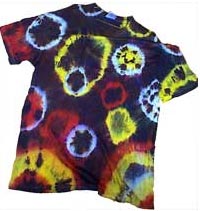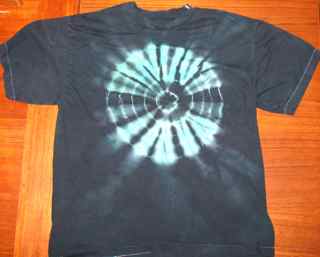Is there a way to do dip dye/tie dye like the way it is done with Rit?
Name: Krista
Message: Is there a way to do dip dye/tie dye like the way it is done with Rit? Except I'm using Procion MX dyes. For example: Triple-dipped Donut & Rosettes Tie-Dye with Rit Dye.
Anything you can do with all-purpose dye, you can do better with fiber reactive dye, such as Procion MX dye. It's easier to do, also, since you do not have to use boiling water (and spoil a good cooking pot!).

In the example at the Rit dye site you linked to, they prepared three separate dyebaths, with yellow, red, and navy dye. They tied the shirt with various sizes of circles and doughnuts, at what appear to be random intervals, where they wanted the fabric to remain white, then dyed in a yellow dyebath. Next, they tied more circles and doughnuts where they wanted the fabric to remain yellow, then dyed in a red dyebath. Finally, they added still more circles where the wanted the fabric to remain red, including some inside and outside the earlier rings, and finally dyed the whole shirt navy blue. None of the ties were removed until after the final dying step was complete.
You can follow the exact same procedure, except for using Procion dye, which as you know is set by adding soda ash instead of heat. Instead of using one box of Rit dye plus 2 gallons of simmering water for each dye color, you can use one tablespoon of Procion MX dye powder, or more or less depending on the color you want, in 1.5 gallons of room temperature water (70°F or warmer), along with a large quantity (1.5 cups) of salt, and three tablespoons of soda ash. Just as in the Rit recipe, the earlier colors of dye will contaminate the later dyebaths, since you're not washing out any excess unattached dye before moving to the next step, but this is not important as long as you chose your colors with the same care, starting with the lightest color and ending with the darkest one.
Alternatively, you can mix up concentrated dyes and apply them directly to the shirt, just as in the standard recipe for tie-dyeing. In this case you would mix one tablespoon of dye and one tablespoon of urea (optional) in one cup of water. You do not need to use salt when you are using a low ratio of water to dye. Either presoak your shirt in soda ash (mixed one cup per gallon of water), or add one-half teaspoon of soda ash to each cup of dye immediately before use. Lay the shirt on a rack or in a plastic dishpan, and squirt the dye on the tied shirt. When tying items that are wet with any sort of dye, be sure to wear reliable gloves.
It would be simpler to use a two-step procedure instead of Rit's three-step procedure, since Procion dyes can be applied directly to the fabric, instead of its being necessary to immerse and simmer them as with Rit dye. First, tie any circles you want to stay white. Then soak the shirt in soda ash, as for ordinary tie-dye. Squirt your different colors of dye, except for the final dark color, on various parts of the untied shirt. You could squirt red on some sections and yellow on others. Leave the dye to react for several hours (or microwave for a quick reaction if you're in a hurry), then rinse the excess dye out of the shirt out to allow for easy handling. Tie circles wherever you want to keep the red and yellow colors, then squirt on navy blue dye, mixed with more soda ash.
Here are a couple of examples of shirts that I dyed black with white circles first, and then overdyed with bright colors:


I used another fiber reactive dye for this project.
(Please help support this web site. Thank you.)
Message: Is there a way to do dip dye/tie dye like the way it is done with Rit? Except I'm using Procion MX dyes. For example: Triple-dipped Donut & Rosettes Tie-Dye with Rit Dye.
Anything you can do with all-purpose dye, you can do better with fiber reactive dye, such as Procion MX dye. It's easier to do, also, since you do not have to use boiling water (and spoil a good cooking pot!).

In the example at the Rit dye site you linked to, they prepared three separate dyebaths, with yellow, red, and navy dye. They tied the shirt with various sizes of circles and doughnuts, at what appear to be random intervals, where they wanted the fabric to remain white, then dyed in a yellow dyebath. Next, they tied more circles and doughnuts where they wanted the fabric to remain yellow, then dyed in a red dyebath. Finally, they added still more circles where the wanted the fabric to remain red, including some inside and outside the earlier rings, and finally dyed the whole shirt navy blue. None of the ties were removed until after the final dying step was complete.
You can follow the exact same procedure, except for using Procion dye, which as you know is set by adding soda ash instead of heat. Instead of using one box of Rit dye plus 2 gallons of simmering water for each dye color, you can use one tablespoon of Procion MX dye powder, or more or less depending on the color you want, in 1.5 gallons of room temperature water (70°F or warmer), along with a large quantity (1.5 cups) of salt, and three tablespoons of soda ash. Just as in the Rit recipe, the earlier colors of dye will contaminate the later dyebaths, since you're not washing out any excess unattached dye before moving to the next step, but this is not important as long as you chose your colors with the same care, starting with the lightest color and ending with the darkest one.
Alternatively, you can mix up concentrated dyes and apply them directly to the shirt, just as in the standard recipe for tie-dyeing. In this case you would mix one tablespoon of dye and one tablespoon of urea (optional) in one cup of water. You do not need to use salt when you are using a low ratio of water to dye. Either presoak your shirt in soda ash (mixed one cup per gallon of water), or add one-half teaspoon of soda ash to each cup of dye immediately before use. Lay the shirt on a rack or in a plastic dishpan, and squirt the dye on the tied shirt. When tying items that are wet with any sort of dye, be sure to wear reliable gloves.
It would be simpler to use a two-step procedure instead of Rit's three-step procedure, since Procion dyes can be applied directly to the fabric, instead of its being necessary to immerse and simmer them as with Rit dye. First, tie any circles you want to stay white. Then soak the shirt in soda ash, as for ordinary tie-dye. Squirt your different colors of dye, except for the final dark color, on various parts of the untied shirt. You could squirt red on some sections and yellow on others. Leave the dye to react for several hours (or microwave for a quick reaction if you're in a hurry), then rinse the excess dye out of the shirt out to allow for easy handling. Tie circles wherever you want to keep the red and yellow colors, then squirt on navy blue dye, mixed with more soda ash.
Here are a couple of examples of shirts that I dyed black with white circles first, and then overdyed with bright colors:


I used another fiber reactive dye for this project.
(Please help support this web site. Thank you.)
Posted: Sunday - June 01, 2008 at 04:10 PM
Follow this blog on twitter here.
Quick Links
- All About Dyes & Dyeing Top -
- Top of this blog -
- FAQ -
- The Dye Forum -
- How to Tie Dye - How to Batik -
- Books - Toys - Plants -
- Top of this blog -
- FAQ -
- The Dye Forum -
- How to Tie Dye - How to Batik -
- Books - Toys - Plants -
More in this category:
- -
Statistics
Total entries in this blog:
Total entries in this category:
Published On: Aug 29, 2012 02:48 PM
Total entries in this category:
Published On: Aug 29, 2012 02:48 PM